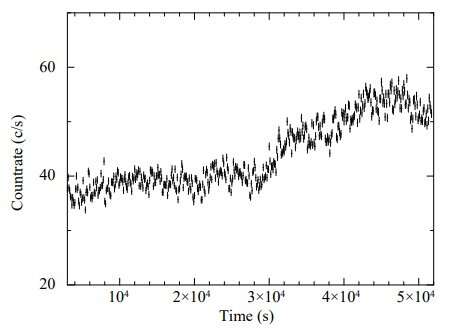December 23, 2020 report
Black hole X-ray binary GRS 1915+105 has a variable magnetic disc wind, study suggests

Using NASA's Chandra spacecraft, astronomers have performed high-resolution X-ray spectroscopic observations of a transient black hole X-ray binary known as GRS 1915+105. They report that the source exhibits a variable magnetic accretion disc wind. The study was detailed in a paper published December 16 on the arXiv pre-print repository.
Black hole X-ray binaries (BHXBs) are binary systems consisting of a black hole orbited by a stellar companion, typically a low-mass, evolved star. In BHXBs, X-rays are produced by material accreting from a secondary companion star onto a black hole primary. Such systems are usually detected in outbursts when the X-ray flux increases significantly.
Due to their high variability and high X-ray flux, BHXBs are excellent targets to study the connection between accretion and ejection mechanisms. In the case of GRS 1915+105, astronomers perceive it as an interesting source that can be used to study the accretion disc wind and how it depends on the state changes in black hole binaries.
Now, a team of astronomers led by Ajay Ratheesh of the Tor Vergata University of Rome, Italy, has conducted a high resolution X-ray spectroscopy of GRS 1915+105 with the Chandra High Energy Transmission Gratings Spectrometer (HETGS). The main goal of the study was to investigate the origin and geometry of the accretion disc wind in this BHXB.
"In this paper, we investigate the origin of the observed abrupt differences in the wind absorption line properties in a soft and hard state of GRS 1915+105 observed with Chandra HETGS," the researchers wrote in the paper.
The team found a series of wind absorption lines in the soft state of GRS 1915+105. These lines appear to follow a nonlinear dependence of velocity width, velocity shift and equivalent width with respect to ionization. This, according to the study, points out to a multiple component or stratified outflow. When it comes to the object's hard state, the astronomers found only a faint absorption line of Fe XXVI.
In general, the researchers say that the results are indicative of a persistent presence of disc winds even during the hard state, although their spectroscopic appearance appears to be much weaker. Moreover, the intrinsic wind condition seems to change internally in different states of GRS 1915+105. Therefore, the results suggest that the disc wind in this binary has a magnetic origin.
"We note that the broad ionization range seen in the absorption lines, interpreted as a multiple component outflow by many authors (Miller et al. 2015, 2016), supports a magnetic origin," the astronomers concluded.
The authors of the paper added that the mass outflow rate of the wind in GRS 1915+105 is comparable to the accretion rate. This finding suggests an intimate link between accretion and ejection processes that lead to state changes in black hole binaries.
More information: A variable magnetic disc wind in the black hole X-ray binary GRS 1915+105?, arXiv:2012.09023 [astro-ph.HE] arxiv.org/abs/2012.09023
© 2020 Science X Network





















